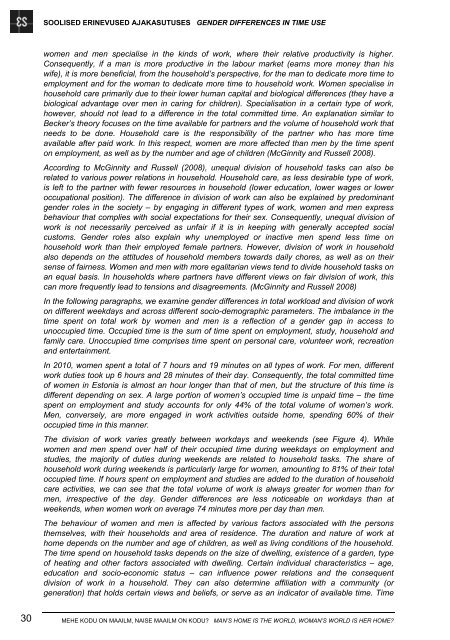MEHE KODU ON MAAILM, NAISE MAAILM ON KODU? - Tartu Ãlikool
MEHE KODU ON MAAILM, NAISE MAAILM ON KODU? - Tartu Ãlikool
MEHE KODU ON MAAILM, NAISE MAAILM ON KODU? - Tartu Ãlikool
You also want an ePaper? Increase the reach of your titles
YUMPU automatically turns print PDFs into web optimized ePapers that Google loves.
SOOLISED ERINEVUSED AJAKASUTUSES GENDER DIFFERENCES IN TIME USE<br />
women and men specialise in the kinds of work, where their relative productivity is higher.<br />
Consequently, if a man is more productive in the labour market (earns more money than his<br />
wife), it is more beneficial, from the household’s perspective, for the man to dedicate more time to<br />
employment and for the woman to dedicate more time to household work. Women specialise in<br />
household care primarily due to their lower human capital and biological differences (they have a<br />
biological advantage over men in caring for children). Specialisation in a certain type of work,<br />
however, should not lead to a difference in the total committed time. An explanation similar to<br />
Becker’s theory focuses on the time available for partners and the volume of household work that<br />
needs to be done. Household care is the responsibility of the partner who has more time<br />
available after paid work. In this respect, women are more affected than men by the time spent<br />
on employment, as well as by the number and age of children (McGinnity and Russell 2008).<br />
According to McGinnity and Russell (2008), unequal division of household tasks can also be<br />
related to various power relations in household. Household care, as less desirable type of work,<br />
is left to the partner with fewer resources in household (lower education, lower wages or lower<br />
occupational position). The difference in division of work can also be explained by predominant<br />
gender roles in the society – by engaging in different types of work, women and men express<br />
behaviour that complies with social expectations for their sex. Consequently, unequal division of<br />
work is not necessarily perceived as unfair if it is in keeping with generally accepted social<br />
customs. Gender roles also explain why unemployed or inactive men spend less time on<br />
household work than their employed female partners. However, division of work in household<br />
also depends on the attitudes of household members towards daily chores, as well as on their<br />
sense of fairness. Women and men with more egalitarian views tend to divide household tasks on<br />
an equal basis. In households where partners have different views on fair division of work, this<br />
can more frequently lead to tensions and disagreements. (McGinnity and Russell 2008)<br />
In the following paragraphs, we examine gender differences in total workload and division of work<br />
on different weekdays and across different socio-demographic parameters. The imbalance in the<br />
time spent on total work by women and men is a reflection of a gender gap in access to<br />
unoccupied time. Occupied time is the sum of time spent on employment, study, household and<br />
family care. Unoccupied time comprises time spent on personal care, volunteer work, recreation<br />
and entertainment.<br />
In 2010, women spent a total of 7 hours and 19 minutes on all types of work. For men, different<br />
work duties took up 6 hours and 28 minutes of their day. Consequently, the total committed time<br />
of women in Estonia is almost an hour longer than that of men, but the structure of this time is<br />
different depending on sex. A large portion of women’s occupied time is unpaid time – the time<br />
spent on employment and study accounts for only 44% of the total volume of women’s work.<br />
Men, conversely, are more engaged in work activities outside home, spending 60% of their<br />
occupied time in this manner.<br />
The division of work varies greatly between workdays and weekends (see Figure 4). While<br />
women and men spend over half of their occupied time during weekdays on employment and<br />
studies, the majority of duties during weekends are related to household tasks. The share of<br />
household work during weekends is particularly large for women, amounting to 81% of their total<br />
occupied time. If hours spent on employment and studies are added to the duration of household<br />
care activities, we can see that the total volume of work is always greater for women than for<br />
men, irrespective of the day. Gender differences are less noticeable on workdays than at<br />
weekends, when women work on average 74 minutes more per day than men.<br />
The behaviour of women and men is affected by various factors associated with the persons<br />
themselves, with their households and area of residence. The duration and nature of work at<br />
home depends on the number and age of children, as well as living conditions of the household.<br />
The time spend on household tasks depends on the size of dwelling, existence of a garden, type<br />
of heating and other factors associated with dwelling. Certain individual characteristics – age,<br />
education and socio-economic status – can influence power relations and the consequent<br />
division of work in a household. They can also determine affiliation with a community (or<br />
generation) that holds certain views and beliefs, or serve as an indicator of available time. Time<br />
30<br />
<strong>MEHE</strong> <strong>KODU</strong> <strong>ON</strong> <strong>MAAILM</strong>, <strong>NAISE</strong> <strong>MAAILM</strong> <strong>ON</strong> <strong>KODU</strong>? MAN’S HOME IS THE WORLD, WOMAN’S WORLD IS HER HOME?

















